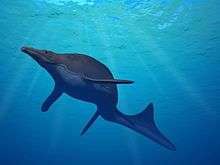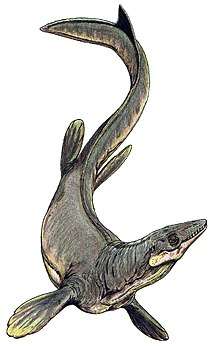Plotosaurus
Plotosaurus ("swimmer lizard") is an extinct genus of mosasaur from the Upper Cretaceous (Maastrichtian) of Fresno County, California. Originally named Kolposaurus (meaning "bay lizard") by Berkeley paleontologist Charles Lewis Camp in 1942, it was changed to Plotosaurus in 1951 when Camp discovered the name had already been assigned to a type of nothosaur.
| Plotosaurus | |
|---|---|
 | |
| Mounted skeleton (LACM CIT 270) at the Los Angeles County Natural History Museum | |
| Scientific classification | |
| Kingdom: | Animalia |
| Phylum: | Chordata |
| Class: | Reptilia |
| Order: | Squamata |
| Superfamily: | †Mosasauroidea |
| Family: | †Mosasauridae |
| Tribe: | †Mosasaurini |
| Genus: | †Plotosaurus Camp, 1951 |
| Type species | |
| †Plotosaurus bennisoni Camp, 1942 | |
| Species | |
| |
| Synonyms | |
| |
Description

Plotosaurs possessed several adaptations to marine life not seen in other mosasaurs. Compared with their relatives, they had narrower flippers, large tail fins and a streamlined fusiform body shape.[1] These features probably enabled them to be faster swimmers than most other mosasaurs. They also had relatively large eyes for keen eyesight, and impressions found with their fossils suggest that they had scaly skin.[1]
Based on cladistic analysis, plotosaurs are considered to be the most derived branch of mosasaur evolution.
Species
The type species, P. bennisoni, was named for Allan Bennison, a fossil hunter who discovered the first remains in 1937. It was around 9 metres (30 ft) long, and was the first known mosasaur from California (a year previously, Bennison had also discovered the state's first dinosaur, a species of Saurolophus that is now known as Augustynolophus).
A second species, P. tuckeri, was also found in 1937 by Frank Paiva and Professor William M. Tucker. Although not quite as advanced in aquatic adaptations as P. bennisoni, it was about 40% larger, reaching lengths of around 13 metres (43 ft). However, a recent analysis by Lindgren, Caldwell and Jagt (2008) considers P. tuckeri to be a junior synonym of P. bennisoni.
Palaeobiology

Studies of Plotosaurus indicate that the animal utilized its pectoral flippers to aid in creating added bursts of speed when attacking prey, utilizing a breaststroke motion, based on the large muscle attachments on the pectoral girdle and asymmetry of the mosasaur's bone structure.[2]
References
- Palmer, D., ed. (1999). The Marshall Illustrated Encyclopedia of Dinosaurs and Prehistoric Animals. London: Marshall Editions. p. 87. ISBN 1-84028-152-9.
- https://www.sciencedaily.com/releases/2019/09/190923140812.htm
- Camp, C.L. 1942. California Mosasaurs. Memoirs of the University of California 13:1-68.
- Camp, C.L. 1951. Plotosaurus, a new generic name for Kolposaurus Camp, preoccupied. Journal of Paleontology 25:822.
- Hilton, R.P. 2003. Dinosaurs and Other Mesozoic Reptiles of California. Berkeley and Los Angeles: University of California Press, 356 pp. ISBN 0-520-23315-8
- Lindgren, J., Jagt, J.W.M., and Caldwell, M.W. 2007. A fishy mosasaur: the axial skeleton of Plotosaurus (Reptilia, Squamata) reassessed. Lethaia 40:153-160.
- Lindgren, J., Caldwell, M.W. and Jagt, J.W.M. 2008. New data on the postcranial anatomy of the California mosasaur Plotosaurus bennisoni (Camp, 1942) (Upper Cretaceous: Maastrichtian), and the taxonomic status of P. tuckeri (Camp, 1942). Journal of Vertebrate Paleontology 28(4):1043-1054.
- Lindgren, J., Alwmark, C., Caldwell, M.W., and Fiorillo, A.R. 2009. Skin of the Cretaceous mosasaur Plotosaurus: implications for aquatic adaptations in giant marine reptiles. Biology Letters doi:10.1098/rsbl.2009.0097.
External links
- Mosasauridae Translation and Pronunciation Guide
- Natural History Museum of Los Angeles County
- UCMP Paleontology Portal
